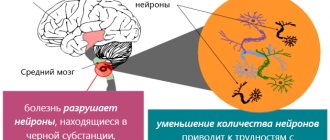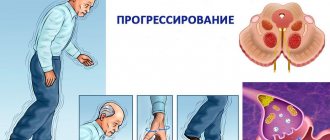How does Parkinson's disease manifest?
— Parkinson's disease belongs to the so-called neurodegenerative diseases, which are characterized by the gradual death of various types of neurons, which leads to a decrease or loss of any functions of the central nervous system. Alzheimer's disease also belongs to this group.
In Parkinson's disease, dopaminergic neurons that produce dopamine die. They are mainly located in the midbrain (the part of the brain responsible for many of its functions, including vision, hearing and coordination of movements - note "Papers") and belong to the basal ganglia system (clusters of gray matter responsible for motor and autonomic functions). functions - note "Paper"), taking part in the regulation of movements, motivation and reinforcement systems.
Due to a decrease in the amount of dopamine, it is precisely these brain functions that disappear: tremors appear, gait is disturbed, muscles become rigid (are in constant tension - note from “Papers”). In the final stage of the disease, when dopamine becomes catastrophically low, people, in the absence of therapy, become very sedentary, they are even called “frozen.” At the same time, thinking abilities in Parkinson's are usually impaired to a lesser extent.
Symptoms of Parkinson's disease: from early to late
Diagnosing Parkinson's disease at an early stage is fraught with great difficulties. Early symptoms are either absent altogether or are characterized by nonspecific manifestations that may not be perceived by people as a serious problem. Some of the first symptoms that may be associated with parkinsonism include:
- frequent or constant weakness, fatigue;
- mild coordination problems;
- slight violations of fine motor skills: for example, it is a little problematic to tie shoelaces, write with a pen;
- the appearance of painful sensations in the neck, lower back, shoulders and shoulder blades, which are often associated with osteochondrosis and arthrosis;
- depressive states, unreasonable anxiety;
- decreased olfactory sensations;
- disturbance of night sleep, but sudden falling asleep occurs during the daytime;
- problems with stool, in particular constipation.
Clinicians explain the development of such conditions, which precede obvious movement disorders, by the involvement of a significant number of nerve structures when neurodegeneration begins. The disease from the presymptomatic to the symptomatic stage occurs in several pathomorphological stages.
- First, the dorsal nuclei of the X cranial nerve and the peripheral part of the olfactory center of the telencephalon are affected.
- Then the brainstem, reticular substance, and locus coeruleus are damaged in a cascade.
- The previous two stages take approximately 2 to 4 years in total. Only then, at the third stage, does the progressive death of neurons in the substantia nigra and other structural components (amygdala, basal ganglia, hypothalamus) begin.
Further, morphological disturbances continue, and, starting from stage 4, when the dopamine deficiency is 60%-80%, clinical symptoms appear. Their spectrum is quite diverse, but the most specific manifestations of parkinsonism are:
- tremor of the distal extremities - usually begins in one arm, and as the disease progresses, it spreads to the other arm and lower extremities;
- trembling of the head and its individual organs - the head trembles in the vertical ("yes-yes" type) and/or horizontal direction ("no-no" type), in addition, tremor of the tongue, eyelids and lower jaw may be observed;
- reduction in involuntary motor activity - general stiffness, freezing in a certain position, active movements at a slow pace are resumed after some delay (bradykinesia);
- puppet gait is when a person walks in small steps with the feet placed parallel to each other, while the arms do not move in a friendly manner and are pressed to the body, the head and body remain frozen;
- facial expression - frozen (petrified) facial expressions that do not correspond to the events taking place (emotions of joy and crying appear with a delay, and subside just as slowly and with a lag);
- speech disorders – the patient’s speech becomes monotonous and inexpressive, intonation is absent or weakly expressed, and tends to fade;
- violation of writing and handwriting - due to the reduced range of movements when writing, the letters become very small, so much so that the author himself is often unable to decipher what is written;
- muscle rigidity is muscle hypertonicity, which in certain muscle groups leads to the formation of a “mannequin” pose (the back is bent and together with the head tilted forward, the arms at the elbows are bent and close to the body, and the legs at the knees and hips are fixed in a position of slight flexion );
- loss of postural reflexes - a serious impairment of coordination of movements when walking, accompanied by difficulties at the start (it is difficult to start movements) and finish (it is impossible to stop the inertia of movement) with loss of the center of gravity (occurs in the later stages, often leading to injury);
- psychosis and vegetative disorders - deviations of the mental state are expressed by hallucinatory-paranoid syndrome, attacks of fear, affect of confusion, insanity, a tendency to repeat the same questions; autonomic dysfunction is manifested by orthostatic disorders, problems with urination and defecation;
- violation of metabolism, secretory functions - often accompanied by obesity or rapid weight loss to the lower limits, excessive secretion of saliva, greasy skin, hyperhidrosis.
Why Parkinson's disease cannot be diagnosed before the first symptoms
— Early diagnosis of this disease is a very big problem. And the search for new diagnostic methods is one of the priorities facing researchers. Now the diagnosis is made on the basis of clinical manifestations, and they appear only when about 80% of dopaminergic neurons have already died.
Positron emission tomography (PET) of the brain can also help in making a diagnosis, but this is a rather expensive procedure and cannot be performed everywhere.
The first manifestations of the disease are different. It’s difficult for me to say which symptoms will be the first, since I don’t work with patients, but, as far as I know, the most common reason for contacting a doctor is the appearance of hand tremors and some lethargy in patients. Patients pay attention to other symptoms after their visit to the doctor, when they are asked specific questions [about the symptoms].
Diagnosis and treatment of Parkinson's disease
Doctors say that if pathology is identified and treated at an early stage (at the very beginning of neuronal death), it would be possible to slow down the speed of the destructive process and prevent the threshold level. So, a person even at 100 years old would not feel signs of the disease. But the trouble is that hardly anyone will go to the doctor if there are no problems. Patients come when symptoms appear, but the neuron reserves are already a disaster, there are almost none left, which makes it impossible to achieve such a long-term plan.
In neurological practice, there is another diagnostic problem: neurologists often make mistakes in making a diagnosis, ignoring the principles of differentiation and complexity. This leads to gross miscalculations in the prescription of symptomatic treatment; the patient often receives inadequate therapy, sometimes at an unreasonably late date. Many are simply being treated for a disease that is not what it actually is. Or they recommend medications and doses that do not correspond to the stage of pathogenesis, the patient’s age, concomitant pathologies, type of profession, etc. As a result, the clinical condition reaches a critical phase, which is why neurosurgical help is often required, that is, brain surgery.
The doctor is obliged to conduct an in-depth assessment of motor, reflective, and mental disorders, then thoroughly differentiate the signs of the disease. However, this is not enough, because a similar clinic is often present in other pathologies and syndromes. For example, with hydrocephalus, brain tumors, depression, hysteria, catatonic stupor, Isaacs syndrome, essential tremor, etc. After examination, only a pathomorphological examination of the brain can finally and reliably determine whether parkinsonism occurs and which structures are simultaneously affected.
Neurosurgeon appointment: study of brain tomography data
Parkinson's disease is a lifelong pathology and cannot be completely cured. To improve the quality of life, the following medications can be prescribed to a patient separately or in combination:
- DA receptor agonists;
- amantadine agonists;
- B-type monoamine oxidase inhibitors;
- catechol-O-methyltransferase inhibitors;
- levodopa drugs.
The principle of action of drugs is aimed at correcting the disturbed biochemical balance in the basal ganglia and replenishing missing substances. As a result, while the patient takes them, the symptoms disappear or become less pronounced. After their withdrawal there is a rapid return of symptoms with a tendency to rapid progression. Medicines have a wide range of contraindications and a number of severe side effects, so they must be chosen very carefully by a good neurologist.
Who is susceptible to Parkinson's disease and why its causes are unknown
— Parkinson's is a disease of older people. There is about a 1–2% chance of occurring after age 60, up to 3% after age 80. There are also earlier forms of the disease, but they are very rare. In young people, the onset of Parkinson's disease may be associated with some kind of toxic exposure.
The disease also develops very differently. For some it happens quickly, for others it takes 20 years. What this is connected with is not yet very clear. Most likely, with the peculiarities of the genetic background of each person.
It is now very difficult to talk about the causes of Parkinson's disease. Researchers are looking at genetic causes, but the percentage of such cases is very small, about 20%. There are a number of genes, mutations in which, presumably, can lead to disease. So genetics in this case has an influence, but not a direct one. The disease of relatives, for example, will not affect the development of Parkinson's.
That is, the reasons may be different, but in general, science currently does not know what is the direct cause of Parkinson’s disease.
Many diseases associated with the central nervous system are difficult to decipher because this system itself is very complexly organized. Hence the problems with diagnosing and studying the causes of Parkinson’s disease.
Who needs prevention of parkinsonism
Regardless of the cause of the development of Parkinson’s disease, the development mechanism is the same: the so-called “substantia nigra” is destroyed. This is an area in the brain where cells that produce the neurotransmitter dopamine are concentrated in the blood. It is involved in the regulation of muscle tone. It is the deficiency of dopamine that causes all manifestations of parkinsonism.
Based on the known causes of Parkinson's disease, we can identify people who are at higher risk of developing it, which means they should think about prevention. Risk groups include:
- People with a family history. It is known that Parkinson's is more likely to manifest itself in those whose parents or grandparents had this diagnosis. This is due to a mutation in the gene that is responsible for the production of dopamine. The altered gene is passed on from generation to generation, and due to a decrease in dopamine levels, symptoms of parkinsonism appear.
- People with chronic heavy metal and pesticide poisoning. Such substances, in addition to their direct harmful effects on the body, tend to accumulate. This leads to metabolic disorders, including in brain tissue and cells that produce dopamine. Human contact with toxic substances may be due to living conditions (a busy road near windows, a railroad, fields treated with pesticides, etc.). Another reason is a violation of safety regulations when working with such substances.
- People with diseases of the cardiovascular system. Disruption of blood flow to the brain tissues in which dopamine is produced leads to the death of these cells and a deficiency of this neurotransmitter.
- People with chronic vitamin D deficiency. In addition to its well-known role in the process of bone mineralization, vitamin D is a “protector” of our cells from the effects of oxidizing substances. With a constant lack of this substance, the process of death of nerve cells accelerates, which negatively affects the level of dopamine in the blood.
- People who have had neuroinfections. The brain or its membranes can be affected by many microorganisms (bacteria, viruses or fungi). Long-term manifestations of meningitis and encephalitis include parkinsonism.
- People with a history of traumatic brain injury. Particular attention should be paid to those who have had several such injuries. Each TBI increases the likelihood of developing neurological disorders and degenerative brain diseases, which include Parkinson's disease.
- People with brain tumors. The tumor can destroy the cells of the substantia nigra or block the blood flow to them. Even after successful tumor removal, it is necessary to regularly consult a doctor and adhere to measures to prevent Parkinson's disease, since the tumor can recur.
Important! Everyone has a risk of developing Parkinson's disease, and it increases as a person ages. After all, the physiological resources of the body in old age are depleted, pathologies of the cardiovascular system develop, and metabolism in all organ systems is disrupted. Therefore, the topic of preventing Parkinson’s disease is relevant to everyone.
How is Parkinson's disease treated and why does it progress even with treatment?
— At the moment, Parkinson's disease is incurable, there is only symptomatic treatment. The main drug for the treatment of Parkinson's disease is L-DOPA. This is a precursor of dopamine, which in the human brain is converted into dopamine and for some time makes up for its deficiency.
In addition to L-DOPA, other drugs are used that affect the dopaminergic system, as well as drugs that relieve some symptoms of the disease. But in a nutshell, we can say that the essence of treatment comes down to stimulating the dopaminergic system to replenish lost brain functions.
But modern treatment has many disadvantages. Firstly, medications do not treat the disease itself, and it is constantly progressing. Secondly, drugs cannot completely replace lost functions. Thirdly, taking L-DOPA leads to the development of side effects, the main of which is addiction, the need to constantly increase the dose of the drug.
In addition, L-DOPA-induced dyskinesia occurs - uncontrolled movements associated with taking the drug. What exactly causes dyskinesia is currently unclear, and therefore it is unclear how it can be treated.
Modern treatment cannot be called sufficiently effective. But you still need to undergo it: it makes life easier and for some time allows you to return to a relatively normal state and control the manifestations of the disease. For some, this treatment can last for decades.
Methods for preventing Parkinson's disease
Measures to prevent the development of parkinsonism are quite simple and do not require large financial investments or waste of time, just the desire to become healthier and willpower is enough. Prevention of Parkinson's begins with lifestyle modifications, nutritional adjustments and treatment of concomitant diseases.
Lifestyle changes
This stage of prevention should begin with the normalization of the daily routine. Sufficient sleep duration is from 7.5 to 10 hours a day. It is important not only the number of hours allotted for rest, but also its quality: a person should sleep in silence and without light, at night. This gives the nervous system the opportunity to rest after a hard day, avoiding overexertion and depletion of neurotransmitters.
The second point is physical activity. It should be daily at moderate intensity or 3-4 times a week at moderate to high intensity. The choice of exercises and the severity of the load should be based on the patient’s health condition, and it is better to coordinate it with the doctor.
Walking at a fast and moderate pace, swimming, water aerobics, and Pilates have practically no contraindications - these are the best options for preventing Parkinson's. Physical exercise, especially in the fresh air, helps saturate the body with oxygen, speed up metabolism, stabilize body weight, and improve mood.
Important! You should not abuse sedatives and sleeping pills as a means of combating stress. Medicines can only be taken as prescribed by a doctor.
To prevent diseases of the nervous system, it is important to avoid exposure to stressful situations. If this fails, you should seek the help of a psychologist. This will help you learn to cope with difficulties without harming your nervous system.
Diet and diet
General recommendations for creating a diet for the prevention of Parkinson's disease do not differ from those for maintaining a healthy lifestyle.
It is necessary to drink enough water: 30 ml per kg of body weight per day. General principles of nutrition for the prevention of Parkinson's disease
| Nutrients | Recommended Sources |
| Squirrels | Lean meats and fish, nuts, legumes, chicken egg whites |
| Fats | Sea fish, vegetable oils, nuts, avocados, egg yolks |
| Carbohydrates | Cereals, vegetables, fruits |
To protect the tissues of the nervous system and prevent pathologies, it is important to consume sufficient amounts of B vitamins and folic acid. This can be achieved by taking vitamin supplements; it is better to consult a therapist or treating neurologist about how to take them correctly.
The main sources of folic acid: greens, all types of lettuce, spinach, arugula, basil, green peas. B vitamins are found in cereals, whole grain bread, and red meat.
Scientific studies have shown that drinking one cup of brewed coffee daily reduces the likelihood of developing Parkinson's disease, and also mitigates the course of existing parkinsonism. But you can drink coffee for prevention only if there are no contraindications, such as hypertension. This point should also be discussed with your doctor.
Doctor consultations and treatment of concomitant diseases
If you have risk factors for the development of Parkinson's disease, you should contact a neurologist for a detailed examination to determine the presence of neurological disorders.
To prevent Parkinson's disease, it is important to take care not only of the health of the nervous system, but also of the body as a whole. It is necessary to be examined by a therapist to identify other diseases that affect metabolic processes and can provoke the development of parkinsonism. These include pathologies of the cardiovascular system, gastrointestinal tract, hypovitaminosis B, anemia and others.
Following all the recommendations of your doctor for the treatment of concomitant diseases significantly reduces the chances of developing Parkinson's disease, even in the presence of risk factors.
Measures to prevent parkinsonism are simple - a healthy lifestyle, proper nutrition, and timely consultation with a doctor. For all this to bear fruit, it is necessary to follow these principles constantly, throughout your life.
When might there be an effective cure for Parkinson's disease?
— Now there is great interest in cell replacement therapy, that is, the creation of a certain type of cells that will help replace lost functions. Parkinson's disease has become one of the first areas where such treatment has already reached clinical trials, testing the effectiveness and safety of the drug in humans.
Several clinical trials for treatments for Parkinson's disease have already begun. Several more should begin at the end of 2019 - beginning of 2020. Each case uses a different source of dopaminergic neurons. It should be noted that researchers in different parts of the world do not work separately, trying to get ahead of each other, but have united into a community that meets once a year and shares their results. Together they identify any difficulties, features, or new approaches. This is exactly what is needed to solve the problem as quickly as possible.
The first trials began last year in Japan, and the first patient was transplanted with [the necessary cells] in November 2021. Clinical trials have also started in China, but I don’t know what stage they are at. Also, clinical trials should begin in Sweden and the USA in the near future. I hope that Russia will join in over time.
The results of Japanese tests should be known by 2023.
Forecast for life
The prognosis is conditionally unfavorable - Parkinson's disease is steadily progressing. Symptoms of movement disorders develop most quickly. Patients who do not receive treatment, on average, lose the ability to care for themselves after 8 years from the onset of the disease, and after 10 years they become bedridden.
- As of the second half of 2011, the vast majority of patients are receiving appropriate treatment. The prognosis in this group is better compared to patients who do not receive adequate therapy. Individuals taking levodopa become dependent on their caregivers after an average of 15 years. However, in each specific case the rate of progression of the disease is different. It has been noted that with the relatively early development of Parkinson's disease, symptoms of impaired motor activity progress most quickly, and when the first symptoms of the disease appear in people 70 years of age and older, mental disorders come to the fore.
- Adequate therapy slows down the development of a number of symptoms leading to disability in patients (muscle rigidity, hypokinesia, postural instability, etc.). However, 10 years after the onset of the disease, the working capacity of most patients is significantly reduced.
The life expectancy of patients is reduced. The ability to work in these patients is permanently and irreversibly lost; depending on the severity of neurological disorders, patients are assigned a disability group.
What to do to reduce the risk of disease
There is no specific prevention for Parkinson's disease. But there are recommendations for the prevention of neurodegenerative diseases in general.
These recommendations boil down to maintaining a healthy lifestyle. A normal work schedule and physical activity are needed: it has been proven that running significantly reduces the progression of such diseases. All fine motor skills and playing musical instruments are demonstrated. Also, eat healthy. Some drugs can be toxic to dopaminergic neurons, so it's a good idea to avoid bad habits.
Life expectancy with Parkinson's disease
The life expectancy of a patient suffering from parkinsonism is determined by a timely diagnosis and correctly prescribed treatment. If the disease is detected at an early stage, effective treatment is prescribed, physiotherapeutic procedures, massage, diet and a healthy lifestyle are prescribed, the patient’s life expectancy can significantly increase.
But you need to understand that Parkinson's disease cannot be completely cured. Therefore, the prognosis for this disease is extremely disappointing. Doctors are unable to stop the progressive development of the disease. It is caused by a number of genetic, physiological, and environmental factors. But, nevertheless, by following all the recommendations and prescribed treatment by the doctor, the development of the disease can be slowed down and the quality of life can be significantly improved.










